| | | OFFLINE | | Post: 19.355
Post: 1.997 | Registrato il: 28/08/2005
Registrato il: 20/01/2009 | Administratore | Utente Veteran | |
|
 GENERAL AUDIENCE TODAY
GENERAL AUDIENCE TODAY
At the General Audience today held in Aula Paolo VI, Pope Benedict XVI resumed his catechetical cycle on the Christian culture of the Middle Ages with a lesson on St. Francis of Assisi.
Here is how he synthesized the catechesis in English:
Continuing our catechesis on the Christian culture of the Middle Ages, we now turn to Saint Francis of Assisi, one of the greatest figures of the Church’s history.
The story of Saint Francis’s life and conversion, and his complete devotion to Christ, the poor and the suffering, is well known. After gathering a small group of companions and followers, including Saint Clare, Francis sought the approval of Pope Innocent III for his movement which was completely committed to the renewal of the Church in holiness and to the preaching of the Gospel.
Near the end of his life, Francis’s configuration to the Crucified Lord culminated in his reception of the stigmata at La Verna. His deep piety found expression in a great devotion to the Eucharist, as the sacrament of Christ’s real presence, and his love for creation as God’s handiwork.
The life and teaching of Saint Francis have inspired countless people to the imitation of Christ through the embrace of inward and outward poverty. May his example teach us ever greater love for the Lord and his Church, and help us to know the immense spiritual joy born of the imitation of Christ and the pursuit of holiness.
At the end of his plurilingual greetings to various pilgrim groups, the Holy Father had a special message to mark the worldwide Holocaust Memorial Day today:
Seventy-five years ago, on January 27, 1945, the gates of the Nazi concentration camp in the Polish city of Oswiecim - known to the world by its German name Auschwitz - were opened to the world, and its few survivors were liberated.
That event and the testimony of the survivors revealed to the world the horrors of the crimes, whose heinousness was hitherto unheard of, committed in the extermination camps created by Nazi Germany.
Today, we celebrate the Day of Memory in honor of all the victims of those crimes, particularly the planned annihilation of the Jewish people, and in honor of those who risked their own lives to protect the victims of persecution and opposed the homicidal folly.
With spirits moved by the memory, let us think of the innumerable victims of a blind racial and religious hatred who underwent deportation, imprisonment and death in those aberrant and inhuman places.
May the remembrance of such deeds, particularly the tragedy of the Shoah which struck the Jewish people, inspire an ever more solid respect for the dignity of every person, so that all men may feel themselves to be one big family.
May the almighty God enlighten hearts and minds so that such tragedies may never again be repeated.
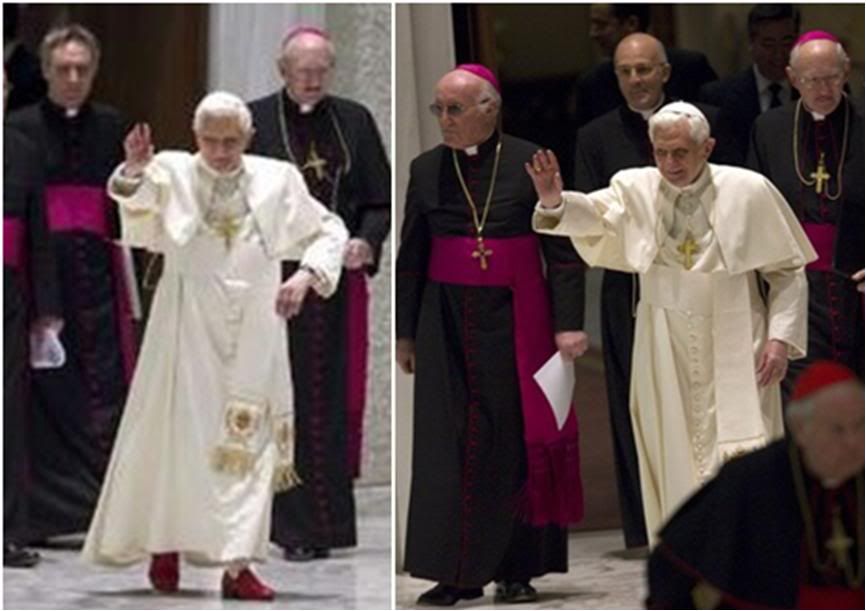
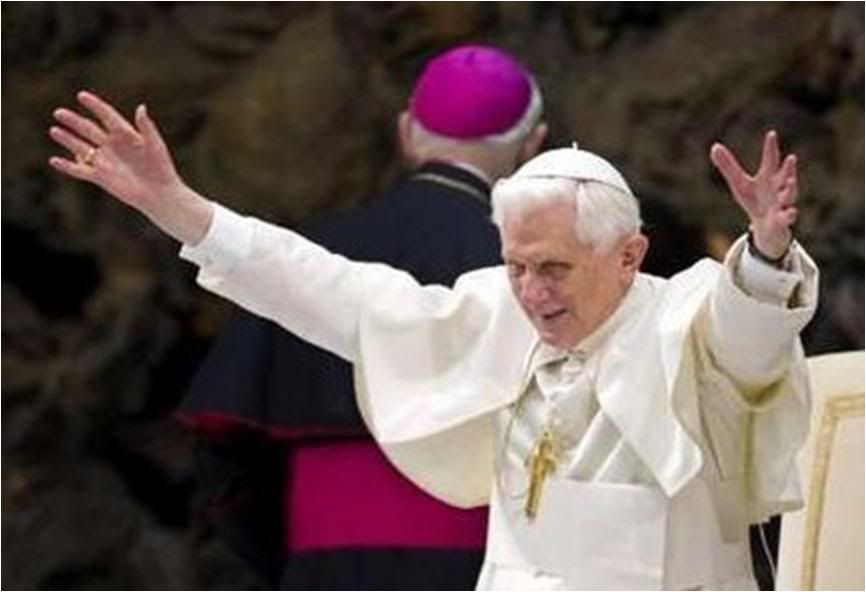
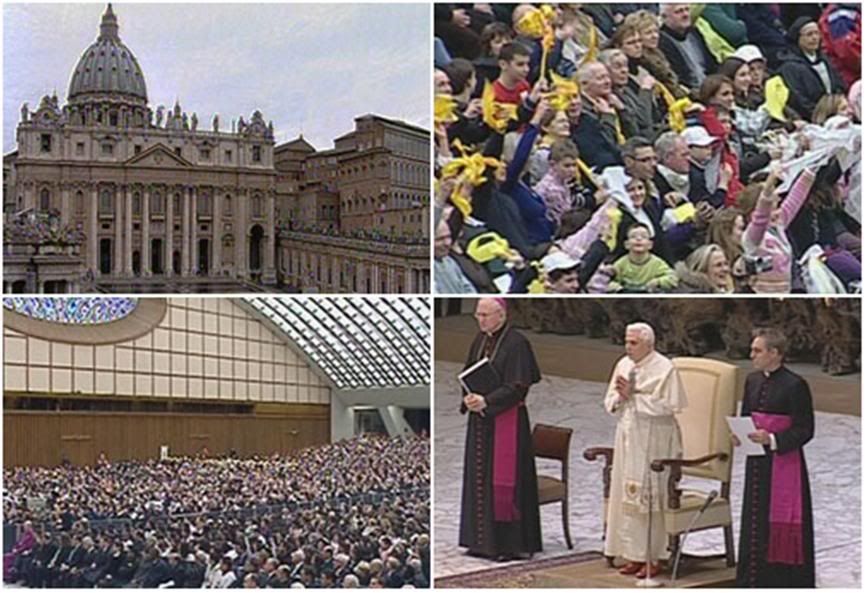
Here is a full translation of the Holy Father's catechesis:

Dear brothers and sisters:
In a recent catechesis, I illustrated the providential role of the Order of Friars Minor and the Order of Preachers - founded, respectively, by Saint Francis of Assisi and St. Domingo de Guzman - in the renewal of the Church in their time.
Today, I wish to present to you the figure of Francis, an authentic 'giant' of sanctity who continues to fascinate so many persons of every age and every religion.
"A sun is born in the world" - With these words in the Divine Comedy (Paradise, Canto XI), the supreme Italian poet Dante Alighieri referred to the birth of Francis, which took place towards the end of 1181 or the start of 1182 in Assisi.
Born to a rich family - his father was a merchant in fabrics - Francis had a carefree adolescence and youth, cultivating the knightly ideals of the time. At age 20, he took part in a military campaign and was taken prisoner. He fell ill and was set free.
After returning to Assisi, he began the slow process of spiritual conversion which led him to gradually abandon the worldly lifestyle that he had practised till then.
Dating back to this time were the famous episodes of his encounter with a leper - to whom, Francis, dismounting from his horse, gave a kiss of peace; and of the message from the Crucifix in the little church of San Damiano.
Three times, Christ on the Cross came to life and said to him: "Go, Francis, repair my church which is in ruins".
These simple words of the Lord heard in the church of San Damiano hide a profound symbolism. At that moment, Francis was called to repair the church itself, but the ruinous state of San Damiano was a symbol of the tragic and disquieting situation of the Church itself in that time, with a superficial faith that failed to form or transform life, with a clergy that showed little zeal, with the chilling of love - an interior destruction of the Church which also meant a decomposition of its unity with the birth of heretical movements.
Nonetheless, at the center of that Church in ruins was the Crucified Lord who spoke: He called for renewal, he called on Francis to do manual labor in order to concretely repair that little church of San Damiano, symbol of the more profound call to renew the Church of Christ itself, with his radical faith and the enthusiasm of his love for Christ.
This event, which took place probably in 1205, would harken forward to a similar event in 1207: the dream of Pope Innocent III. He saw in a dream that the Basilica of St. John Lateran, mother church of all churches, was collapsing, and a small, insignificant religious was propping up the church with his shoulders to keep it from falling.
It is interesting to note that that it was not the Pope who was helping to keep the Church from collapsing, but a small insignificant religious, whom tehe Pope would recognize in Francis when the latter visited him.
Innocent II was a powerful Pope, with great theological culture as well as great political power. Nonetheless, it was not he who would renew the Church but the small and insignificant religious - St. Francis, who was called by God.
On the other hand, it is also important to note that St. Francis would not renew the Church without or against the Pope, bot only in communion with him.
The two realities go together: The Successor of Peter, the Bishops, the Church founded on the apostolic succession, and the new charism which the Holy Spirit creates at a moment in time to renew the Church. Together, they lead to the growth of true renewal,
Let us return to teh life of St. Francis. When his father Bernardone reproached him for being too generous to the poor, Francis, in front of the Bishop of Assisi, cast aside his garments in a symbolic gesture to renounce his paternal legacy.
As at the moment of Creation, Francis had nothing, only the life gven him by God, into whose hands he delivered himself. He then lived as a hermit until, in 1208, another fundamental event took place in the itinerary of his conversion.
Listening to a passage from the Gospel of St. Matthew - Jesus's discourse to the apostles he was sending out on mission - Francis felt that he was called to live in poverty and to dedicate himself to preaching.
Some friends joined him, and in 1209, he went to Rome in order to submit to Innocent III a plan for a new form of Christian life. He received a paternal welcome from that great Pontiff who, enlightened by the Lord, sensed the divine origin of the movement inspired by Francis.
The Poverello [Poor One] of Assisi had understood that every charism given by the Holy Spirit must be placed in the service of the Body of Christ which is the Church - and that is why, he always acted in full communion with ecclesiastical authority.
In the lives of saints, there is no opposition between prophetic charism and the charism of governance, and if any tension should come to be, the saints know how to await patiently the time determined by the Holy Spirit.
Actually, some historians of the 19th century and even the last century, sought to create behind the Francis of tradition a so-called historical Francis, just as they sought to create behind the Jesus of the Gospels a so-called historical Jesus.
And their historical Francis was not a man of the Church, but a man linked directly only to Christ, a man who wanted to create a renewal among the People of God, without canonical forms nor hierarchy.
The truth is that St. Francis did have a very immediate relationship with Jesus and with the Word of God that he wanted to fallow without gloss - as it is, in all its radicalness and truth.
It is also true that initially, he had no intention of creating an Order with the required canonical forms, but simply with the Word of God and the presence of the Lord, to renew the People of God, call them again to listening to the Word and to verbal obedience to Christ.
Moreover, he knew that Christ is never 'mine', but is always 'ours', that Christ could not have him as an 'I' that would reconstruct against the Church, her wishes and her teaching - but only in communion with the Church built on the apostolic succession, to renew obedience to the Word of God, as well.
It is true he did not intend to create a new Order, but only to renew the People of God for the Lord who would come again. But he understood through suffering and pain that everything should have its own order, that the law of the Church was necessary to give form to renewal, and thus he situated himself totally, with all his heart, in communion with the Church, with the Pope and his Bishops.
He always knew that the center of the Church is the Eucharist, where the Body and Blood of Christ become present. Through the priesthood, the Eucharist is the Church. Where the priesthood and Christ and communion of the Church go together, only there dwells the Word of God.
The true historical Francis is the Francis of the Church, and it is as such that he continues to speak even to non-believers and to the believers of other confessions and religions.
Francis and his brother friars, who became increasingly more numerous, established themselves at the Porziuncola, the Church of Santa Maria degli Angeli, the spiritual site par excellence of Franciscan spirituality.
Even Clare, a young lady of Assisi, from a noble family herself, followed the school of Francis. Thus started the Second Franciscan Order, that of the Poor Clares, another experience destined to produce illustrious figures of sainthood in the Church.
The successor to Innocent II, Pope Honorius III, with the papal bull Cum dilecti in 1218, sustained the singular development of the Friars Minor who went on to open missions in different countries of Europe, and even in Morocco.
In 1219, Francis got permission to go to Egypt in order to talk to the Muslim Sultan Melek-el-Kâmel, to preach the Gospel of Jesus even in that country.
I wish to underscore this episode in the life of St. Francis for its great actuality today. In an age when a confrontation between Christianity and Islam was underway, Francis - voluntarily armed with nothing but his faith and his personal gentleness - pursued the way of dialog effectively.
The accounts tell us he got a benevolent and cordial welcome from the Muslim sultan. It is a model that should inspire Christian-Muslim relationships today: to promote a dialog in truth, reciprocal respect and mutual comprehension (cfr Nostra aetate, 3).
It seems that later, in 1220, Francis visited the Holy Land, thus sowing a seed that has borne much fruit: his spiritual sons, in fact, made of the places where Jesus lived a favored area for their mission. With gratitude, I think of the great merits of the Franciscan Custody of the Holy Land.
Returning to Italy, Francis turned over the administration of the Order to his vicar, Fra Pietro Cattani, while the Pope entrusted the protection of the rapidly growing Order to Cardinal Ugolino, the future Pope Gregory IX.
On his part, the Founder, totally devoted to preaching which he carried out with great success, wrote out a Rule for the Order, which was later approved by the Pope.
In 1224, at the hermitage of La Verna, Francis had a vision of the Crucified Lord in the form of a seraph, and from that encounter, he received the stigmata, thus becoming one with the Crucified Christ - a gift that manifested his intimate identification with the Lord.
The death of Francis - his transitus - took place on the evening of October 2, 1226, in the Porziuncola. After blessing his spiritual children, he died, lying on the bare earthen floor.
Two years later, Pope Gregory IX enrolled him in the book of saints. And not long after, a great basilica was built in his honor in Assisi - which continues today to be the destination of countless pilgrims who can venerate the saint's tomb and enjoy in it the frescoes of Giotto, who painted magnificently the episodes in the Life of Francis.
It has been said that Francis represents an alter Christus - and indeed he was truly a living icon of Christ. He was also called 'brother of Jesus'.
Indeed, his ideal was to be like Jesus; to contemplate Christ of the Gospel, to love him intensely, and to imitate his virtues. In particular, he wished to give a fundamental value to exterior and interior poverty, which he taught to his spiritual children.
The first Beatitude of the Sermon on the Mount - "Blessed are the poor in spirit for theirs is the Kingdom of Heaven" (Mt 5,3) - finds its luminous realization in the life and words of St. Francis.
Truly, dear friends, the saints are the best interpreters of the Bible. Incarnating the Word of God in their lives, they make it more attractive than ever, so that it truly speaks to us.
The testimony of Francis, who loved poverty so he could follow Christ with total dedication and freedom, continues to be, even for us, an invitation to cultivate interior poverty in order for our trust in God to grow, united with a moderate lifestyle and a detachment from material goods.
In Francis, love for Christ was especially expressed in adoration of the Most Holy Sacrament of the Eucharist. In the original Franciscan texts, we read moving expressions of this such as: "All mankind is in awe, the entire universe trembles and the heavens exult, when on the altar, in the hands of the priest, there is Christ, Son of the living God. What a stupendous favor! What humble sublimeness! that the Lord of the Universe, God and Son of God, can be so humble as to hide himself for our salvation in the modest form of bread!" (Francesco di Assisi, Scritti, Editrici Francescane, Padova 2002, 401).
In this Year for Priests, I gladly recall a recommendation made by Francis to priests: "When they wish to celebrate Mass - pure themselves and in a pure manner - may they, with reverence, make the true sacrifice of the most holy Body and Blood of our Lord Jesus Christ" (Francesco di Assisi, Scritti, 399).
Francis always showed great deference towards priests, and reocmmended that they should always be respected, even when they are personally unworthy. The reason for this profound respect was the fact that they had received the gift of consecrating the Eucharist.
Dear brothers in the priesthood, let us never forget this teaching: the sacredness of the Eucharist requires us to be pure, and to live in a way consistent with the Mystery that we celebrate.
From love for Christ is born love for persons and for all God's creatures. This was another feature characteristic of Francis's spirituality: the sense of univesal brotherhod and love for Creation, which inspired his famous Canticle of creation.
It is a very actual message. As I recalled in my recent encyclical Caritas in veritate, development is sutainable only when it respects creation and does not damage the environment (cfr Nos. 48-52), and in the Message for World Peace Day this year, I also underscored that even building solid peace is linked to respect for Creation.
Francis reminds us that the wisdom and benevolence of the Creator is manifested in all of Creation. He understood Nature as a language with which God speaks to us, in which reality becomes transparent, and we can speak of God and with God.
Dear friends, Francis was a great saint and a joyous man. His simplicity, his humility, his faith, his love for Christ, his goodness towards every man and every woman, brought him joy on every occasion. Indeed, there subsists an intimate and indissoluble relationship between holiness and joy.
A French writer has said that there is only one sorrow in the world: not to be saints, that is, not to be close to God. Looking at the testimony of St. Francis, we understand that this is the secret of true happiness: to become holy, close to God.
May the Virgin, so tenderly loved by Francis, obtain this gift for us. Let us entrust ourselves to her with the words of the Poverello of Assisi himself: "Blessed Virgin Mary, no one like you among women has been born in the world, daughter and handmaid of the Most High King and heavenly Father, Mother of our Most Blessed Lord Jesus
Christ, spouse of the Holy Spirit: Pray for us...to your most Blessed Son, Lord and Master" (Francesco di Assisi, Scritti, 163).

 Pope remembers Holocaust victims and
Pope remembers Holocaust victims and
those who risked their lives to defend Jews
Adapted from

VATICAN CITY, Jan. 27 (AsiaNews) - In his General Audience today, Benedict XVI discussed St. Francis of Assisi as an icon of Christ and a model of dialogue with Muslims, who acted in union with the Church.
After the catechesis, he spoke about Holocaust Memorial Day, marked in Europe in the past 10 years on January 27, anniversary of the liberation of Auschwitz camp by Allied forces in 1945.
The Pope said: "We remember the horror of crimes of unprecedented cruelty, committed in the extermination camps established by Nazi Germany," especially the planned annihilation of the Jews, "and also how man" risked their lives, to protect the persecuted, opposing the murderous folly."
Benedict XVI said he prays that "the memory of these facts, particularly the tragedy of the Holocaust that affected the Jewish people, will inspire an increasingly convinced respect for the dignity of every person, that all men perceive themselves to be one great family. Almighty God enlighten hearts and minds, so that such tragedies never happen again" ....
[The rest of the AsiaNews story quotes chunks of the catechesis, so I have omitted it since I have a full translation of the catechesis itself above.]
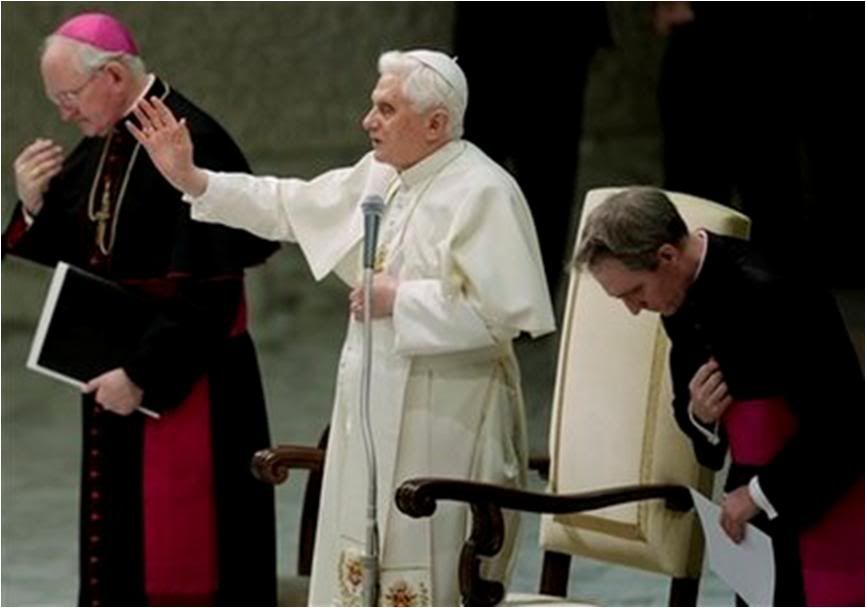 Pope blesses boy with
Pope blesses boy with
muscular dystrophy
Translated from

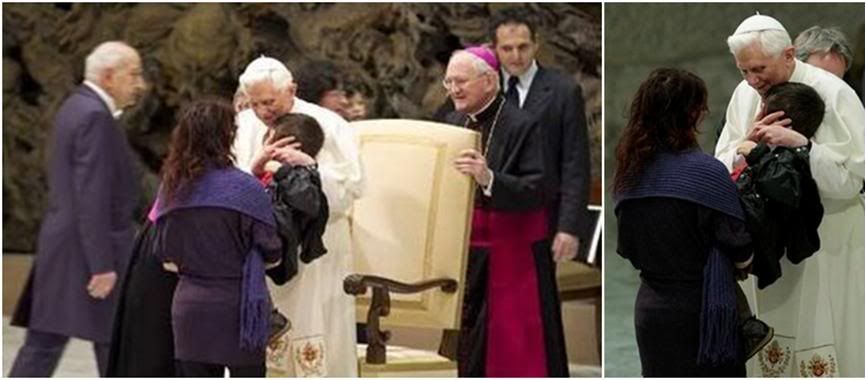
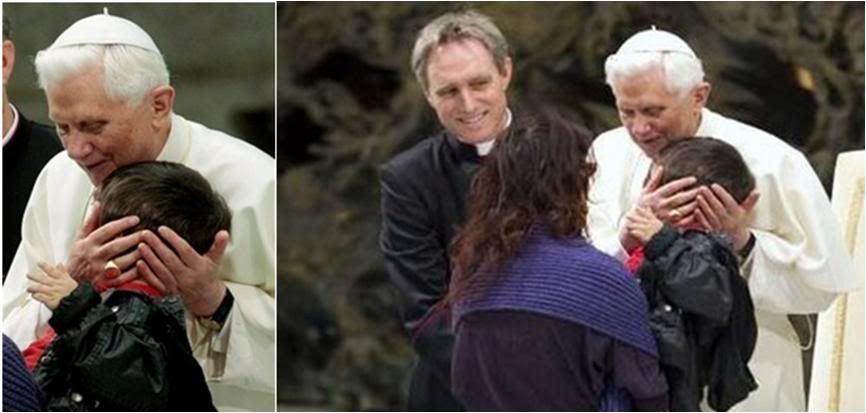
In one of the sidelights after the General Audience today, Pope Benedict blessed three-year-old Danlele Amanti, who has muscular dystrophy and is the subject of the book Daniele. Storia di un bambino che spera (Daniel: The story of a boy who hopes), written by Cinzia Lacalamita and published byAliberti.
The boy came with his parents and two Italian actors who appear in a campaign against muscular dystrophy, or Duchesne's disease, which afflicts 50,000 young people in Italy, affecting one male out of every 3500. (Women are carriers of the defective gene which causes the disease).
The initiative was born on Facebook, where Daniele's parents, Fabio and Eliana, after recounting the story of their child, have gained solidarity from thousands of 'friends', among whom they can now count the Holy Father.
 I believe there is enough material now for a volume on Benedict XVI's discourses about St. Francis. The nucleus would be this catechesis and the marvelous discourses he delivered on his visit to Assisi in 2007.
I believe there is enough material now for a volume on Benedict XVI's discourses about St. Francis. The nucleus would be this catechesis and the marvelous discourses he delivered on his visit to Assisi in 2007.
In recent weeks, he had two other catecheses on St. Francis - one before Christmas on how the Poverello started the beautiful tradition of recreating the Nativity scene, and the recent one on how the mendicant orders (Franciscans and Dominicans) catalyzed the renewal of the Church in the 13th century.
Then there was his address to the Franciscans on the 800th anniversary of the order. I also recall some Angelus mini-homilies on the saint of Assisi, and a couple of those Q&A with priests and seminarians in which he spoke about St. Francis.
Not to forget that in JESUS OF NAZARETH, Vol. I, he devotes two pages in the chapter on the Sermon on the Mount to St. Francis as 'the most intensely lived illustration of the first Beatitude', as he recalls in today's catechesis.

[Modificato da TERESA BENEDETTA 18/02/2010 09:44] |